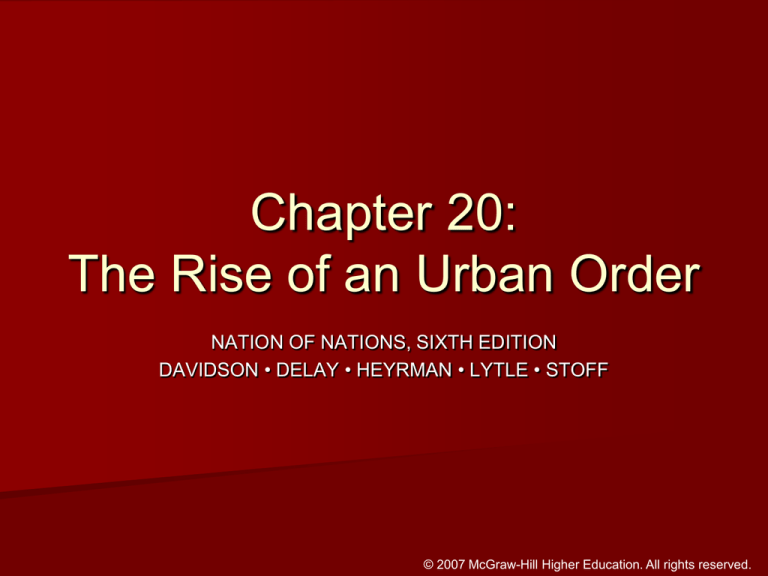
Chapter 20:
The Rise of an Urban Order
NATION OF NATIONS, SIXTH EDITION
DAVIDSON • DELAY • HEYRMAN • LYTLE • STOFF
© 2007 McGraw-Hill Higher Education. All rights reserved.
2
Preview
“At the center of the new industrial order was the
city. But to accommodate the global migration of
laborers and families, to support the sprawling
factories and the masses who kept them going,
urban centers of the late nineteenth century had
to reinvent themselves.”
© 2007 McGraw-Hill Higher Education. All rights reserved.
3
The Highlights
A New Urban Age
Running and Reforming the City
City Life
City Culture
© 2007 McGraw-Hill Higher Education. All rights reserved.
Day 1
Who was Andrew Carnegie?
What is urbanization?
What is immigration?
© 2007 McGraw-Hill Higher Education. All rights reserved.
5
A New Urban Age
The Urban Explosion
– USA population tripled, urban population 7
fold
– Cities’ relations to regions around them
shaped natural and economic
environments
– Farms to feed, lumber consumed, etc…
The Great Global Migration
– Jobs, over population, Louis Pasteur
discovered bacteria causes infection
© 2007 McGraw-Hill Higher Education. All rights reserved.
6
Immigration and Population, 1860-1920
© 2007 McGraw-Hill Higher Education. All rights reserved.
The Shape of the City
– Ringed settlement with city center and zones of
emergence from poverty
– Suburban homes
Urban Transportation
– Electricity Trolley, Cable & Street car, Suburbs
– Mass transit freed the middle class and poor to
live miles from work
Bridges and Skyscrapers
– Suspension bridges
– Cloudscrapers: open floors ideal for
warehouses, office buildings and department
stores
7
© 2007 McGraw-Hill Higher Education. All rights reserved.
8
Growth of New Orleans to 1900
© 2007 McGraw-Hill Higher Education. All rights reserved.
9
© 2007 McGraw-Hill Higher Education. All rights reserved.
Chap 15 sec 1 The Americans pg 39
© 2007 McGraw-Hill Higher Education. All rights reserved.
Day 2
Define mass transit
List two examples of mass transits at the
beginning of the 20th century
How did mass transit lead to the rise of
suburbs?
© 2007 McGraw-Hill Higher Education. All rights reserved.
12
Slum and Tenement
– Perils of the slum neighborhood
alcoholism, gangs, prostitution, gambling,
crime
– Diets and disease led to early death
– Sewage and Water Purification helped
– Dumbbell tenement spread “like a scab”
window shafts filled with garbage and fire
spread
© 2007 McGraw-Hill Higher Education. All rights reserved.
13
Running and Reforming the City
Boss Rule
– Political machine- organization that
controlled a political party headed by a
political boss
– The boss made $ through dealings
– A crude welfare system for supporters
Rewards, Costs and Accomplishments
– Boss William Tweed and Tammany Hall
made $13 million off of $250,000
– Bosses guided immigrants and helped
© 2007 McGraw-Hill Higher Education. All rights reserved.
14
Nativism, Revivals, and the Social Gospel
– Nativism: a defensive and fearful nationalism
blamed economic woes on foreigners
– Chinese Exclusion Act (1882): banned the entry
of Chinese laborers
– Social Gospel: focused on improving the
conditions of society Salvation Army
The Social Settlement Movement
– The settlement house living in the slums
– Jane Adam’s Hull House 1889
– Lobbied for social legislation to improve housing,
women’s working conditions and public schools
© 2007 McGraw-Hill Higher Education. All rights reserved.
20-4 Jane Adams
© 2007 McGraw-Hill Higher Education. All rights reserved.
Day 3
What is the Social Gospel Movement?
How did Boss Tweed commit graft?
What was a tenement?
© 2007 McGraw-Hill Higher Education. All rights reserved.
17
© 2007 McGraw-Hill Higher Education. All rights reserved.
18
City Life
The Immigrant in the City
– Ethnic neighborhoods with a 10 year
turnover
– Adapting to America language and
customs
– Married later & more kids & less education
– Chinese Exclusion Act 1882 led to more
gangs, prostitution, crime, males after San
Francisco earthquake 1906 paper children
– Assimilation difficult for kids & parents
© 2007 McGraw-Hill Higher Education. All rights reserved.
19
Victorianism and the Pursuit of Virtue
– Victorianism- personal conduct be based on
orderly behavior and disciplined moralist,
manners essential, gender roles w/ women as
void vessels devoid of lust, men lustful beast
– Woman’s Christian Temperance Union later “Do
Everything” prostitution, education, suffrage
© 2007 McGraw-Hill Higher Education. All rights reserved.
Comstock Law (1873) fought pornography
Banned all material designed to icnite lust
Challenges to Convention
3/4 of women enjoyed sex, 1/3 of woman had
abortion, and the use of animal sheaths
Victoria Woodhull ran for president 1872 “I am
a free lover”
© 2007 McGraw-Hill Higher Education. All rights reserved.
Chap 15-2 The Americans pg
53
© 2007 McGraw-Hill Higher Education. All rights reserved.
Day 4
What was the Chinese Exclusion Act?
What was Nativism?
How did Nativism and the Chinese
Exclusion Act dispel the idea of America
as a melting pot?
© 2007 McGraw-Hill Higher Education. All rights reserved.
23
City Culture
Public Education in an Urban Industrial World
– 1870 50% no education 20% illiterate
– 1870-1900: an educational awakening
occurred
– Schools taught conformity and values in
addition to reading, writing and arithmetic
– Mc Guffey reader
Higher Learning and the Rise of the
Professional
– Morrill Act of 1862 created land grant
© 2007 McGraw-Hill Higher Education. All rights reserved.
African American education
1900 50 % of African Americans could read
Plessey v. Ferguson 1896 dismantled educational
gains
W.E.B. Du Bois- PHD from Harvard founded Niagara
Movement insisting Blacks should pursue liberal arts
education in order to have well educated
community leaders
Booker T Washington- racism would end once
Blacks acquired useful skills and proved their
economic value to society- founded Tuskegee
Institute to this end
© 2007 McGraw-Hill Higher Education. All rights reserved.
A Culture of Consumption
– Department stores
– Chain stores and mail-order houses
Leisure
– Sports and class distinctions
– Spectator sports for the urban masses
Arts and Entertainment
– The streets, the saloon, dance halls, boxing
exhibitions, concerts and theater
– Popular music and the coming of jazz
– Circus- Barnum & Bailey- utilized railroads
25
© 2007 McGraw-Hill Higher Education. All rights reserved.
AP PAGE 209-211
© 2007 McGraw-Hill Higher Education. All rights reserved.
Day 5
Where did W.E.B. Du Bois go to school?
What did Booker T Washington believe about
education?
What was the Niagara Movement?
© 2007 McGraw-Hill Higher Education. All rights reserved.






